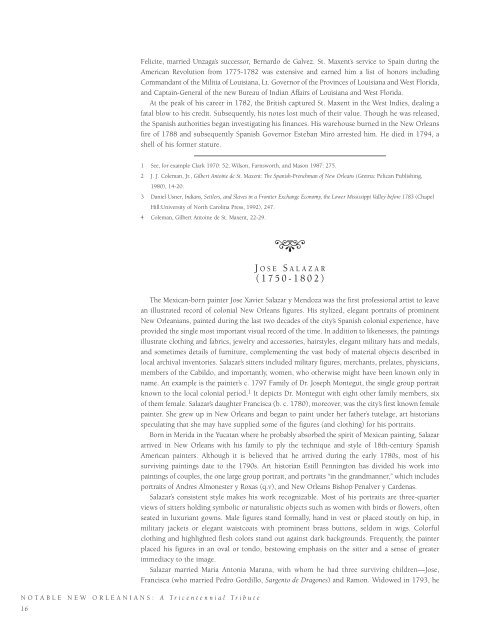Notable New Orleanians: A Tricentennial Tribute
An illustrated history of New Orleans paired with the histories of companies that have helped shape the city.
An illustrated history of New Orleans paired with the histories of companies that have helped shape the city.
Create successful ePaper yourself
Turn your PDF publications into a flip-book with our unique Google optimized e-Paper software.
Felicite, married Unzaga’s successor, Bernardo de Galvez. St. Maxent’s service to Spain during the<br />
American Revolution from 1775-1782 was extensive and earned him a list of honors including<br />
Commandant of the Militia of Louisiana, Lt. Governor of the Provinces of Louisiana and West Florida,<br />
and Captain-General of the new Bureau of Indian Affairs of Louisiana and West Florida.<br />
At the peak of his career in 1782, the British captured St. Maxent in the West Indies, dealing a<br />
fatal blow to his credit. Subsequently, his notes lost much of their value. Though he was released,<br />
the Spanish authorities began investigating his finances. His warehouse burned in the <strong>New</strong> Orleans<br />
fire of 1788 and subsequently Spanish Governor Esteban Miró arrested him. He died in 1794, a<br />
shell of his former stature.<br />
1 See, for example Clark 1970: 52; Wilson, Farnsworth, and Mason 1987: 275.<br />
2 J. J. Coleman, Jr., Gilbert Antoine de St. Maxent: The Spanish-Frenchman of <strong>New</strong> Orleans (Gretna: Pelican Publishing,<br />
1980), 14-20.<br />
3 Daniel Usner, Indians, Settlers, and Slaves in a Frontier Exchange Economy, the Lower Mississippi Valley before 1783 (Chapel<br />
Hill:University of North Carolina Press, 1992), 247.<br />
4 Coleman, Gilbert Antoine de St. Maxent, 22-29.<br />
<br />
J OSE<br />
S ALAZAR<br />
(1750-1802)<br />
The Mexican-born painter Jose Xavier Salazar y Mendoza was the first professional artist to leave<br />
an illustrated record of colonial <strong>New</strong> Orleans figures. His stylized, elegant portraits of prominent<br />
<strong>New</strong> <strong>Orleanians</strong>, painted during the last two decades of the city’s Spanish colonial experience, have<br />
provided the single most important visual record of the time. In addition to likenesses, the paintings<br />
illustrate clothing and fabrics, jewelry and accessories, hairstyles, elegant military hats and medals,<br />
and sometimes details of furniture, complementing the vast body of material objects described in<br />
local archival inventories. Salazar’s sitters included military figures, merchants, prelates, physicians,<br />
members of the Cabildo, and importantly, women, who otherwise might have been known only in<br />
name. An example is the painter’s c. 1797 Family of Dr. Joseph Montegut, the single group portrait<br />
known to the local colonial period. 1 It depicts Dr. Montegut with eight other family members, six<br />
of them female. Salazar’s daughter Francisca (b. c. 1780), moreover, was the city’s first known female<br />
painter. She grew up in <strong>New</strong> Orleans and began to paint under her father’s tutelage, art historians<br />
speculating that she may have supplied some of the figures (and clothing) for his portraits.<br />
Born in Merida in the Yucatan where he probably absorbed the spirit of Mexican painting, Salazar<br />
arrived in <strong>New</strong> Orleans with his family to ply the technique and style of 18th-century Spanish<br />
American painters. Although it is believed that he arrived during the early 1780s, most of his<br />
surviving paintings date to the 1790s. Art historian Estill Pennington has divided his work into<br />
paintings of couples, the one large group portrait, and portraits “in the grandmanner,” which includes<br />
portraits of Andres Almonester y Roxas (q.v), and <strong>New</strong> Orleans Bishop Penalver y Cardenas.<br />
Salazar’s consistent style makes his work recognizable. Most of his portraits are three-quarter<br />
views of sitters holding symbolic or naturalistic objects such as women with birds or flowers, often<br />
seated in luxuriant gowns. Male figures stand formally, hand in vest or placed stoutly on hip, in<br />
military jackets or elegant waistcoats with prominent brass buttons, seldom in wigs. Colorful<br />
clothing and highlighted flesh colors stand out against dark backgrounds. Frequently, the painter<br />
placed his figures in an oval or tondo, bestowing emphasis on the sitter and a sense of greater<br />
immediacy to the image.<br />
Salazar married Maria Antonia Marana, with whom he had three surviving children—Jose,<br />
Francisca (who married Pedro Gordillo, Sargento de Dragones) and Ramon. Widowed in 1793, he<br />
NOTABLE NEW ORLEANIANS: A <strong>Tricentennial</strong> <strong>Tribute</strong><br />
16
















